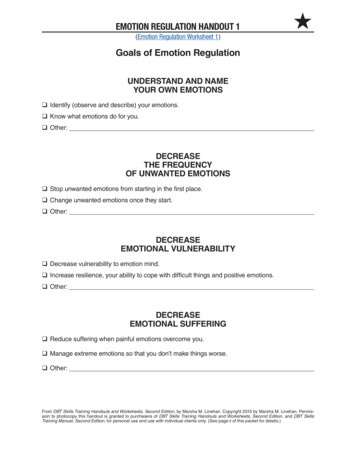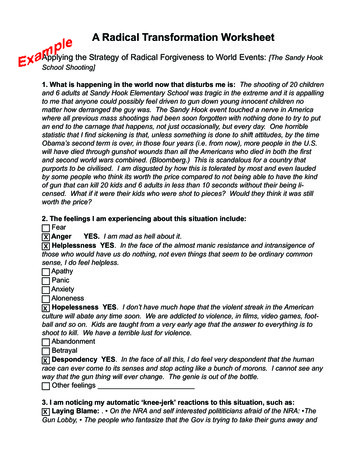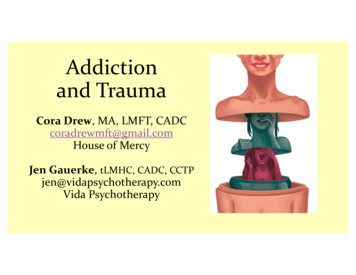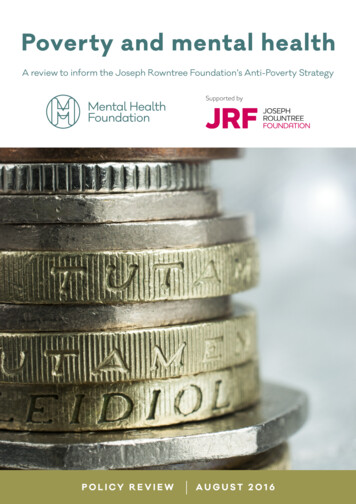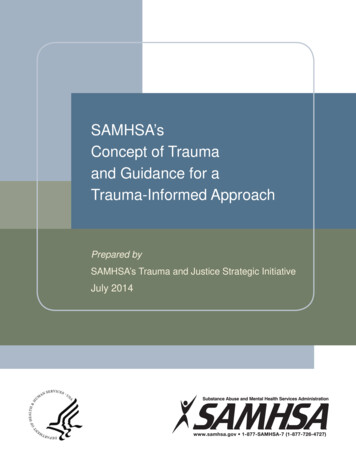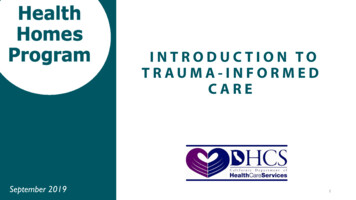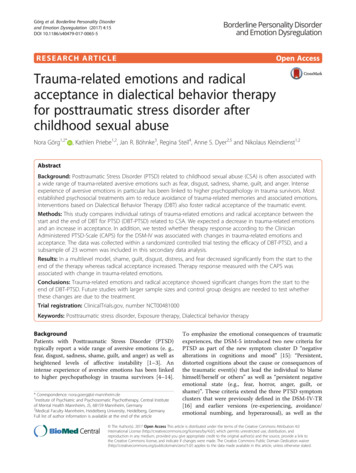
Transcription
Görg et al. Borderline Personality Disorderand Emotion Dysregulation (2017) 4:15DOI 10.1186/s40479-017-0065-5RESEARCH ARTICLEOpen AccessTrauma-related emotions and radicalacceptance in dialectical behavior therapyfor posttraumatic stress disorder afterchildhood sexual abuseNora Görg1,2* , Kathlen Priebe1,2, Jan R. Böhnke3, Regina Steil4, Anne S. Dyer2,5 and Nikolaus Kleindienst1,2AbstractBackground: Posttraumatic Stress Disorder (PTSD) related to childhood sexual abuse (CSA) is often associated witha wide range of trauma-related aversive emotions such as fear, disgust, sadness, shame, guilt, and anger. Intenseexperience of aversive emotions in particular has been linked to higher psychopathology in trauma survivors. Mostestablished psychosocial treatments aim to reduce avoidance of trauma-related memories and associated emotions.Interventions based on Dialectical Behavior Therapy (DBT) also foster radical acceptance of the traumatic event.Methods: This study compares individual ratings of trauma-related emotions and radical acceptance between thestart and the end of DBT for PTSD (DBT-PTSD) related to CSA. We expected a decrease in trauma-related emotionsand an increase in acceptance. In addition, we tested whether therapy response according to the ClinicianAdministered PTSD-Scale (CAPS) for the DSM-IV was associated with changes in trauma-related emotions andacceptance. The data was collected within a randomized controlled trial testing the efficacy of DBT-PTSD, and asubsample of 23 women was included in this secondary data analysis.Results: In a multilevel model, shame, guilt, disgust, distress, and fear decreased significantly from the start to theend of the therapy whereas radical acceptance increased. Therapy response measured with the CAPS wasassociated with change in trauma-related emotions.Conclusions: Trauma-related emotions and radical acceptance showed significant changes from the start to theend of DBT-PTSD. Future studies with larger sample sizes and control group designs are needed to test whetherthese changes are due to the treatment.Trial registration: ClinicalTrials.gov, number NCT00481000Keywords: Posttraumatic stress disorder, Exposure therapy, Dialectical behavior therapyBackgroundPatients with Posttraumatic Stress Disorder (PTSD)typically report a wide range of aversive emotions (e. g.,fear, disgust, sadness, shame, guilt, and anger) as well asheightened levels of affective instability [1–3]. Anintense experience of aversive emotions has been linkedto higher psychopathology in trauma survivors [4–14].* Correspondence: nora.goerg@zi-mannheim.de1Institute of Psychiatric and Psychosomatic Psychotherapy, Central Instituteof Mental Health Mannheim, J5, 68159 Mannheim, Germany2Medical Faculty Mannheim, Heidelberg University, Heidelberg, GermanyFull list of author information is available at the end of the articleTo emphasize the emotional consequences of traumaticexperiences, the DSM-5 introduced two new criteria forPTSD as part of the new symptom cluster D “negativealterations in cognitions and mood” [15]: “Persistent,distorted cognitions about the cause or consequences ofthe traumatic event(s) that lead the individual to blamehimself/herself or others” as well as “persistent negativeemotional state (e.g., fear, horror, anger, guilt, orshame)”. These criteria extend the three PTSD symptomclusters that were previously defined in the DSM-IV-TR[16] and earlier versions (re-experiencing, avoidance/emotional numbing, and hyperarousal), as well as the The Author(s). 2017 Open Access This article is distributed under the terms of the Creative Commons Attribution 4.0International License (http://creativecommons.org/licenses/by/4.0/), which permits unrestricted use, distribution, andreproduction in any medium, provided you give appropriate credit to the original author(s) and the source, provide a link tothe Creative Commons license, and indicate if changes were made. The Creative Commons Public Domain Dedication o/1.0/) applies to the data made available in this article, unless otherwise stated.
Görg et al. Borderline Personality Disorder and Emotion Dysregulation (2017) 4:15central affective symptoms of restricted affect, distressduring confrontation with trauma triggers, and irritability/outbursts of anger.Trauma-focused treatments have shown to be efficacious for PTSD [17]. They reduce avoidance of memories and associated emotions. Research on affectivechanges in trauma-focused therapy has focused primarilyon fear and non-specific distress-partly as a consequenceof Foa and Kozak’s influential Emotional ProcessingTheory [18]. Within this framework, a pathological “fearstructure” is defined as the central component of anxietydisorders and PTSD [19]. The framework posits that thereduction of fear and distress over the course of severalexposure sessions (between-session) leads to reducedexpectations of threat and subsequently to a change inthe fear structure. Consequently, the between-sessionchanges in self-reported fear and distress were hypothesized to be important process variables.However, emotional consequences of trauma can differwidely between patients. In a pilot study by Power andFyvie [20], about half of the 75 patients with mixedtrauma types reported fear as the most prevalent emotion since the traumatic event. The other half reported aprimary experience of disgust, sadness or anger that wasassociated with longer periods since the onset of psychological problems. Patients with interpersonal violenceexposure (IPV) in particular reported elevated ratings ofshame, guilt, fear, disgust, and anger in several studies[1, 2, 21]. Thus, focusing on emotions other than fearmight be particularly relevant in studies on IPV-relatedPTSD [22, 23].Studies showed that fear, shame, guilt, sadness, anger,and disgust significantly decrease from the start to theend of trauma-focused therapy [22, 24–28]. To date, anumber of studies have investigated the link betweenPTSD symptomatology according to the DSM and fearor distress experienced within trauma-focused therapy[26, 29–36]. A recent meta-analysis showed that abetween-session decrease in fear and distress is associated with a decrease of PTSD symptoms as defined bythe DSM [37]. However, only a few studies have focusedon links between PTSD symptomatology and othertrauma-related emotions in trauma-focused therapy. Inone study on women with IPV-related PTSD, a higherbetween-session decrease in sadness and anger was associated with remission after exposure therapy [26]. In thatstudy, remission was defined according to the PTSDSymptom Scale-Interview (PSS-I) [38], and emotions wereassessed during sessions. Similarly, another study measured PTSD symptomatology (re-experiencing, avoidance,and dissociation) as well as trauma-related emotions during a repeated imagery rescripting task for women withsexual assault experience. As a result, a between-sessiondecrease in disgust was predictive of reduced PTSDPage 2 of 12symptomatology during the task but only in women whoshowed a significant between-session decrease in fear [39].In contrast, a study of combat veterans did not find anystatistically significant correlations between sadness, anger,and guilt as experienced during imaginal flooding sessionsand the number of daily intrusions after therapy [28].In other studies, emotions were not assessed intherapy sessions, but were assessed in other settingsindependent of therapeutic interventions. In one of thesestudies, patients with mixed trauma types receivedtrauma-focused therapy and rated weekly levels oftrauma-related shame and guilt [40]. Weekly changes inboth emotions were positively correlated with subsequent changes in the PTSD Symptom Scale – SelfRating (PSS-SR) [38]. Similarly, reductions in guilt frompre to mid treatment predicted reductions in theClinician-Administered PTSD Scale (CAPS) [41] in astudy with trauma-focused therapy for patients withIPV-related PTSD [24]. A study on psychotherapy forpatients with PTSD related to childhood sexual abuse(CSA) who were at risk for Human ImmunodeficiencyVirus showed conflicting findings [25]: Pre-post-therapyreductions in shame, but not in guilt, correlated significantly with reductions in the Posttraumatic Stress Disorder Checklist–Specific (PCL-S) [42]. Overall, empiricaldata suggest that the between-session decrease in fear anddistress is a potential proxy for changes in PTSD symptomatology as defined by the DSM-IV and earlier versions.However, the question of whether other trauma-relatedemotions are similarly relevant requires further investigation. To date, only a few studies [26, 28] have assessed awide range of trauma-related emotions rather than onlyone or two specific emotions [25, 27, 40].Another PTSD symptom cluster is avoidance andemotional numbing [15]. A recent meta-analysis linkedthe tendency to avoid painful emotions, thoughts, andmemories (“experiential avoidance”) [43] to the severityof PTSD symptoms in samples with various traumatypes [44]. “Third wave therapies” such as Acceptanceand Commitment Therapy (ACT) [45] or DialecticalBehavior Therapy (DBT) [46] stress the importance ofaccepting and tolerating aversive emotions. For example,DBT teaches the concept of “radical acceptance”, whichinvolves the acceptance of unchangeable emotions,thoughts, and unchangeable circumstances [46]. Steiland colleagues [47] combined elements of DBT withtrauma-focused cognitive interventions and exposuretherapy for patients with PTSD after CSA (DBT-PTSD)[48–51]. Following the DBT concept of radical acceptance, DBT-PTSD encourages patients to accept pasttraumatic events, painful memories of those events, andemotions about having experienced such adversities (instead of avoiding, rejecting and fighting). Some empiricalevidence on the importance of acceptance comes from
Görg et al. Borderline Personality Disorder and Emotion Dysregulation (2017) 4:15ACT for patients with chronic pain where acceptance ofpain mediated the treatment effect on physical functioning [52]. To our knowledge, no previous empirical studyhas yet examined the pre to post change of radicalacceptance in DBT. Given the central role that radicalacceptance plays in DBT-based treatments, it would beclinically relevant to test whether this variable is subjectto change.Research questionsIn summary, some empirical evidence has shown thattrauma-related emotions decline between the start andthe end of trauma-focused treatments. In addition,higher decreases in fear and distress between therapysessions were linked to higher decreases in PTSD symptomatology according to the DSM-IV and earlier versions. However, research about the link between PTSDsymptomatology and trauma-related emotions beyondfear is limited. It also remains unclear whether radicalacceptance according to DBT definitions changes fromthe start to the end of DBT-based trauma-focused therapy. This study investigates the change in trauma-relatedemotions and radical acceptance from the start to theend of DBT-PTSD. We hypothesized that there wouldbe a decrease in all negative trauma-related emotionsand an increase in radical acceptance over time. Furthermore, the study aims to replicate the well-establishedlinks between distress, fear, and PTSD symptomatology.Potential links between other trauma-related emotions,radical acceptance and PTSD symptomatology accordingto the CAPS [41] are also explored. The data were collected within a subsample of a randomized controlledtrial (RCT) which tested the efficacy of DBT-PTSD. Inthe original study, DBT-PTSD was found to be superiorto a treatment-as-usual waitlist control group (TAU)with large effect sizes in a self-reported and clinicianadministered PTSD measure. The main results werepublished elsewhere [48]. Here, only data from patientsreceiving DBT-PTSD was analyzed.MethodsSampleFemale participants aged 17 to 65 years old with a currentdiagnosis of PTSD related to CSA were included in theRCT [48]. In addition, at least one of the following criteriahad to be met: meeting four or more DSM-IV criteria ofborderline personality disorder (BPD), current eatingdisorder, current major depressive disorder, or currentsubstance abuse. While PTSD in trauma-exposed sampleswith a history of CSA is frequently accompanied by comorbidities such as substance abuse, alcohol abuse, orBPD [53], patients with such comorbidities as well as eating disorders or increased suicide risk are often excludedfrom studies [54–57]. To increase the external validityPage 3 of 12these comorbidities were included in the original RCT.Exclusion criteria were: medical contraindications for exposure treatment (e.g., severe cardiovascular disorders;body mass index 16.5), life-threatening behavior within4 months prior to study entry, intellectual disability, a lifetime diagnosis of schizophrenia or bipolar I disorder, or acurrent diagnosis of substance dependence.Within the RCT, patients were randomized to receiveeither DBT-PTSD or the TAU. In the DBT-PTSD group,39 patients started the therapy. After the study period,all patients from the TAU group (n 39) were offeredDBT-PTSD treatment and 32 of the 39 patients startedthe treatment. To increase the sample size, this analysisincluded both patients from the original DBT-PTSD trialarm as well as patients from the TAU group if they received DBT-PTSD after the original study period. Onlydata collected during the DBT-PTSD treatment were included. Ratings of emotions and acceptance were introduced at a later stage of the study period, so that dataon trauma-related emotions would be available for asubsample. Our analysis required at least two assessments of trauma-related emotions during the start (week2–4) and end (final two consecutive weeks before discharge) of therapy. These data were available for 28 patients, and 23 patients completed the diagnostic sessionsat the beginning and end of therapy. Within the finalsample of 23 patients, 15 patients came from the DBTPTSD group and 8 patients were originally in the TAUgroup and eventually received the active treatment.TreatmentParticipants received between 12 and 14 weeks of a modular residential treatment at the PTSD unit of the CentralInstitute for Mental Health, Mannheim, Germany (CIMH).The detailed treatment protocol of this study is describedelsewhere [48]. Week one to week four mainly includedpsychoeducation of PTSD: teaching of DBT skills andidentification of individual avoidance behavior (e. g.dissociation, self-harm, and cognitive denial). Patientsreceived imaginal exposure from week five to week 10.Between the sessions, patients listened to audio-recordingsof the exposure sessions as a self-administered exposureexercise. During exposure, DBT interventions (e.g., distraction skills) could be used to ensure awareness of thepresent as opposed to dissociative states or flashbacks.Furthermore, emotion regulation strategies could beapplied to down-regulate overwhelming emotional responses. In addition, there were cognitive interventionsthat focused on guilt and discrimination between thecurrent and the traumatic situation [58]. In the final2 weeks, specific interventions aimed at achieving radicalacceptance. Patients received biweekly psychotherapy sessions and took part in several group activities (11 sessionsof 90 min DBT skills training, eight 60 min sessions of
Görg et al. Borderline Personality Disorder and Emotion Dysregulation (2017) 4:15skills training for self-esteem, 35 sessions of 25 min mindfulness training, 11 sessions of 60 min psychoeducationon PTSD and weekly group interventions on music or arttherapy). The therapy was delivered by clinical psychologists with additional training in DBT and trauma-focusedtherapy. Participants in the TAU-WL group were allowedto seek any kind of treatment except for DBT-PTSDwithin the 6-month study period.AssessmentsDiagnosis of PTSD following CSA and axis I comorbidities were checked with the Structured Clinical Interviewfor DSM-IV Axis I Disorders [59]. BPD symptoms werediagnosed with the International Personality DisorderExamination (IPDE) [60]. The outcome measure used inthis study was the CAPS [41]. Ratings referred to theindex event, i.e., the traumatic situation that is currentlycausing the highest level of distress. Global psychopathology was assessed with the Symptom Checklist 90-R(SCL-90-R) to compute the Global Severity Index (GSI)[61]. The CAPS was assessed before and after DBTPTSD treatment. Ratings on trauma-related emotionswere filled out directly before treatment sessions. Originally, these assessments served as a feedback instrument tomeasure the patients’ progress regarding trauma-relatedemotionality. It was not designed for study purposes. Inthe questionnaire, patients were asked to think of theindex event and then rate their levels of shame, guilt, distress, disgust, fear, anger, sadness, and radical acceptancein response to it. The scale ranged from 0 (not at all) to100 (maximum). Psychoeducation in all trauma-relatedemotions and radical acceptance was offered in the skillsgroups of the treatment.Statistical analysesTo test which emotions were predominant at the start(week 2–4) of the treatment, eight two-sided t-tests witha Bonferoni corrected Alpha level of α .006 were computed. Each t-test compared scores for one variable withthe average of all other variables (emotions and acceptance). To investigate whether trauma-related emotionsdecreased (and acceptance increased) over time, wetested whether these assessments changed on averagebetween the start (week 2–4) and the end (final 2 weeks)of therapy. This was done on a descriptive level and withmultilevel models (MLM). Next, we tested whethertreatment outcome as assessed with the CAPS had anincremental effect on predicting trauma-related emotions and acceptance. For each treatment phase (start vs.end), at least two and up to seven assessments oftrauma-related emotions and acceptance per patientwere available (see Fig. 1). The MLM used repeated datathat were nested within patients.Page 4 of 12Four models for each emotion and acceptance werecomputed. In model 1, we estimated the intra-class correlations (ICCs) for these data without the informationwhether the rating was at the start or at the end of thetreatment. This quantifies the amount of observed differences between patients, and it serves as a baseline modelto test whether adding predictors significantly increasesmodel fit.In model 2, we added the treatment phase (0 start;week 2–4 vs. 1 end of treatment, final 2 weeks beforedischarge) as a fixed effect on the level of the patient.According to the DBT-PTSD protocol, these two treatment phases correspond with the pre- and post-exposurephase. This fixed effect therefore captures the average difference between treatment phases across all patients.In models 3 and 4, we tested whether treatment outcome had an incremental effect on trauma-related emotions and acceptance. Treatment outcome was eitherincluded as a dichotomous (model 3) or as a continuouspredictor (model 4). In model 3, we included whetherthe patient responded to the therapy or not; (“response”)as a dichotomous predictor on the between-patient level.“Response” was defined as a reduction in CAPS scoresof at least 30 from the start to the end of the treatment[48, 62]. In model 4, we used the reduction in the CAPSscores from the start to the end of the treatment as acontinuous predictor on the between-patient level. Bothwere added as fixed effects to the model. Patients wereincluded as a random effect in all models. Further detailson the MLMs can be found in Additional file 1.To choose the model with the best fit to the data weused the corrected Akaike information criterion (AICc)which has been shown to be more appropriate in smallersamples-especially in models for longitudinal data [63, 64].Lower values indicate a better fit. We evaluated whetherthe inclusion of treatment phase as a predictor increasedmodel fit relative to a non-trend model when predictingtrauma-related emotions and acceptance (comparison between model 2 and model 1). We also evaluated whetherincluding therapy outcome as a predictor had an incremental effect on model fit (comparison between model 3and model 2 and between model 4 and model 2). Furthermore, R2 was computed to illustrate the fit of the modelsto the data. This represents the squared correlation between the observed values and the predicted values of eachmodel based on the included fixed effects. The weight ofevidence (W) was computed to illustrate the probabilitythat a model provides the best fit when compared with thethree other models [63]. W states how likely each model isthe best available approximation of the data comparedto the other available models. For graphs and descriptives we used IBM SPSS Statistics 21; MLM analysiswere done with the R software version 3.1.3 [65],package lme4 [66].
Görg et al. Borderline Personality Disorder and Emotion Dysregulation (2017) 4:15Page 5 of 12Fig. 1 Illustration of data inclusion: Change of distress ratings of a participant. Sessions within weeks 2–4 were used to calculate emotion scoresat the start of the treatment. The end of the treatment comprised the final 2 weeks before admission (weeks 13 and 14). Only sessions marked ingrey were used to estimate the modelsResultsSample characteristicsThe average age of the all-female sample was 36.3(SD 10.5; range 20 to 52 years). Patients initially hadan average CAPS severity score of 88.1 (SD 15.2)which was comparable to the original entire RCT sample(M 85.2, SD 16.38) [48]. The average GSI in our subsample was 1.99 (SD 0.66) (entire sample: M 1.95,SD 0.62). Patients in our subsample showed an averagedecrease in CAPS scores of 32.0 (SD 25.7). Of the 23patients, 14 fulfilled the response criterion at the end ofthe therapy (reduction of at least 30 points reduction inthe CAPS [42]). For responders, the average decrease inCAPS scores was 51.8 (SD 19.2) and 10.8 for nonresponders (SD 9.6). Within this subsample, 12 patients (52%) fulfilled a diagnosis of BPD according to theIPDE compared to 45% in the entire RCT sample. Onaverage, patients in our subsample fulfilled 4.3 BPD criteria (SD 2.0) and 4.06 (SD 1.88) in the entire sample. In this subsample, patients had an average of 2.78axis I disorders compared to 3.01 axis I comorbiditiesacross the entire sample. The most frequent comorbidityin both samples was major depression (subsample: 83%,entire sample: 80%). Altogether, 78% of patients in the subsample (86% in the entire sample) received psychotropicmedication-most of them antidepressants (subsample andwhole sample: 70%). A more detailed description ofthe entire RCT sample can be found in the mainpaper [48].Data descriptionSix of the eight t-tests that compared one variable (emotion or acceptance) with the average score of all othervariables at the start of the therapy were significant.Only the t-tests for fear and sadness were non-significant. In line with Power’s and Fyvie’s findings [20],patients did not report one predominant emotion at thestart of the treatment, but showed heightened levels ofdifferent emotions. We illustrated whether a change inemotions resp. acceptance could be observed betweenthe start (week 2–4) and the end (final 2 weeks beforedischarge) of therapy. Figure 2 shows that all of thetrauma-related emotions decreased over time, whereasradical acceptance increased. This pattern of change isin line with our prior expectations.Multilevel modelingMLMs for the prediction of each trauma-related emotion and acceptance were computed separately. Next,the fit of models was compared between model 1 (notrend), model 2 (inclusion of therapy phase as a predictor), model 3 (inclusion of therapy phase and response as predictors), and model 4 (inclusion of therapyphase and CAPS change as predictors) based on theAICc. The model parameters can be found in Table 1.According to the AICc scores, model 1 showed theworst fit (highest AICc values) for each trauma-relatedemotion and acceptance. Thus, the models including thetime in therapy were superior to the baseline models. Thefixed effects were all in line with our hypotheses (that theintensity of negative emotions would decrease over timewhile acceptance would increase). When adding therapyresponse as a dichotomous predictor (model 3), the modelfit increased further for every emotion and acceptance.When adding therapy response as a dimensional predictor(model 4), model fit increased only in the case of fearin comparison to model 2. However, in all cases,model 3 is the most parsimonous description of thedata (lowest AICc).
Görg et al. Borderline Personality Disorder and Emotion Dysregulation (2017) 4:15Page 6 of 12Fig. 2 Change in trauma-related emotions and acceptance; Mean 1 SE of trauma-related emotions at the start and end of the treatment. Inbrackets: Standardized mean of the differences (SMD)Table 1 Fit statistics for the different models for each emotion and acceptance. Model 3 operationalized therapy outcome asresponse (CAPS reduction of at least 30 points from the start to the end of the therapy vs. non-response). Model 4 operationalizedtherapy outcome as absolute reduction in CAPS scores from start to endGuilta,bModel 1 (no trend)Model 2 (linear trendof therapy phase)Model 3 (linear trend oftherapy phase and response)Model 4 (linear trend oftherapy phase and CAPS 29.63W0.000.080.900.02.15.16.15R2Notea 2R : correlation between observed and predicted values of each modelbW: Weight of evidence for model in the context of all other models
Görg et al. Borderline Personality Disorder and Emotion Dysregulation (2017) 4:15The results are explained in detail for one emotion toillustrate the selection decisions. In the case of guilt,models 1 and 2 receive very low weights of evidence, indicating that adding response as a predictor (model 3)increases the fit to the data substantially. Model 3 islikely the most appropriate model compared to all othermodels.It has the lowest AICc score (1522.38) and thehighest W (0.92) of all four models. This indicates thatnot only the inclusion of the response increases preditivepower (compared to models 1 and 2), but that the inclusion of the dichotomous response provided better fitthan the continuous CAPS score (model 4, W .02). Toconclude, the overall therapy outcome assessed with theindependent criterion CAPS adds information only whenused as a dichotomous predictor (response vs nonresponse)-not when used as a continuous predictor. Thetrends described for guilt are found for all variables andonly for fear the dimensional predictor of therapy response (model 4) added some predictive value.Table 2 presents the estimated fixed effects of model 3for all emotions and acceptance. All estimates for the effect of treatment phase had expected trends, with decreases for emotions and increases of acceptance ratings.The estimated changes differ widely, from a decrease of6.20 points in sadness to a 35.41 decrease in guilt.Similarly, the response in the CAPS correlates with a reduction in emotions between 1.01 points (sadness) and18.85 points (fear). Due to the size of the sample, thestandard errors of the individual effects are rather largeand changes in anger and sadness over time are notstatistically robust because their respective standarderrors would lead to non-significant estimates (size ofestimated coefficient compared to 1.96 x SE). For the association with CAPS response, only fear and perhapsdistress can be seen as robust with regard to the significance of the individual predictors (see Fig. 3).Page 7 of 12In a post hoc analysis, we additionally compared traumarelated emotions at three different time points: t0 (start ofthe treatment), t1 (2 weeks prior to discharge), and t2 (endof the treatment) via repeated measures t-tests and standardized means of the differences (SMD). The comparisonbetween t1 and t2 corresponds with the start and the endof the acceptance-focused interventions. While guilt(SMD 1.12) and shame (SMD 0.72) declined significantly from t0 to t1, non-significant reductions were foundin distress (SMD 0.45), disgust (SMD 0.34), sadness(SMD 0.13), anger (SMD 0.14), fear (SMD 0.38)and non-significant increases in acceptance (SMD 0.42).Non-significant reductions between t1 and t2 were foundin guilt (SMD 0.59), fear (SMD 0.54), disgust(SMD 0.50), shame (SMD 0.35), distress(SMD 0.34), sadness (SMD 0.32), and anger(SMD 0.03), whereas acceptance (SMD 0.51) increased non-significantly. Thus, the variables changed inthe expected direction in all treatment phases (startof treatment, start and end of acceptance-focusedinterventions).DiscussionThis study investigated whether trauma-related emotions and radical acceptance changed from the start tothe end of DBT-PTSD. Furthermore, the potential linkbetween this change and the therapy response accordingto the Clinician-Administered PTSD Scale was explored[41]. Expanding upon previous studies, we not only investigated the role of fear and distress but also includedother trauma-related emotions and radical acceptance.Overall, statistically parsimonious descriptions of thedata suggest that patients experienced statistically significant reductions in shame, guilt, disgust, distress, andfear and increases in radical acceptance from the start tothe end of t
types [44]. "Third wave therapies" such as Acceptance and Commitment Therapy (ACT) [45] or Dialectical Behavior Therapy (DBT) [46] stress the importance of accepting and tolerating aversive emotions. For example, DBT teaches the concept of "radical acceptance", which involves the acceptance of unchangeable emotions,

